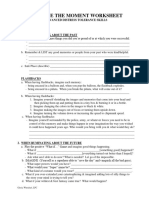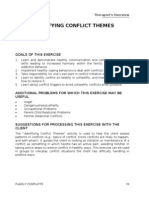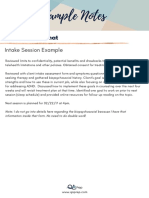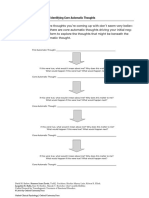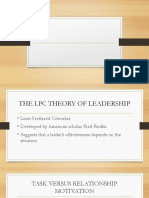How To Use Worry Time
How To Use Worry Time
Uploaded by
KaviCopyright:
Available Formats
How To Use Worry Time
How To Use Worry Time
Uploaded by
KaviOriginal Title
Copyright
Available Formats
Share this document
Did you find this document useful?
Is this content inappropriate?
Copyright:
Available Formats
How To Use Worry Time
How To Use Worry Time
Uploaded by
KaviCopyright:
Available Formats
Worry Time
Most people worry about things from time to time, and worrying can
sometimes be helpful. For example, worry can:
Help us identify unpleasant things that might happen in the future
Motivate us to avoid these things
Keep us safe in potentially dangerous situations
However, worry can become a problem if:
You worry about things you can't change or control
You have trouble controlling your worrying
Worrying interferes with your ability to enjoy your life or get things
done
If your worrying has become problematic, then you might benefit from
using Worry Time. Worry time is a simple, effective strategy for
managing worry and reducing its impact on your life.
How To Use Worry Time
Set aside some time once or twice a day (e.g., 15 minutes in the
afternoon) specifically for worry.
When you worry outside of that time, stop and make a mental or
physical note to think about this worry during Worry Time.
Shift your focus back to whatever you were doing.
If that worry comes up again, repeat steps 2 and 3 and remind
yourself that you will return to this worry later.
During your designated Worry Time:
Think through all of your worries in as much depth as you like.
Differentiate between what worries you can solve, and what worries
you can't.
Make notes about how you could address solvable worries and how
you might react to unsolvable ones.
Once your Worry Time is finished, stop! If any worries are still niggling at
you, remind yourself to focus on them in your next Worry Time.
Copyright © THIS WAY UP, St Vincent's Hospital Sydney Limited
Worry Time Tips
During Worry Time, you can:
Evaluate your worries. How realistic are they? How likely are they to
come true? If they did come true, would it be as bad as you think?
What would you do to cope?
Consider whether you're worrying about something that really
matters to you, or whether you're worrying out of habit.
Consider whether worrying about this issue is helpful. Is the problem
fixable or preventable? Does worrying change the situation?
Consider the costs of worrying about this issue. Does it make you
stressed or irritable? Does worrying get in the way of other things?
Write down your thoughts. This can help you get some distance from
your worries, and keep a record of any great solutions you come up
with!
After Worry Time, you can:
Use Structured Problem Solving to address fixable problems.
Do something relaxing to relieve stress and muscle tension, like deep
breathing, stretching or going for a walk.
Other tips:
Don't do Worry Time right before you go to sleep, as it can take a
while to 'unwind' afterwards. Leave time to read a book or do some
stretches before you try to sleep.
Read over your thoughts from previous Worry Times and notice
whether you're still worrying about the same things. Did worrying
help any of those situations?
Copyright © THIS WAY UP, St Vincent's Hospital Sydney Limited
You might also like
- Worksheet Practicing Radical AcceptanceDocument1 pageWorksheet Practicing Radical Acceptancesyasya ibrahimNo ratings yet
- Improve The Moment WorksheetDocument6 pagesImprove The Moment Worksheetavabellegerwell100% (1)
- Case Formulation NadinDocument8 pagesCase Formulation NadinNashwa ElAraby100% (1)
- Dialectical Dilemma TherapistDocument3 pagesDialectical Dilemma TherapistRosalie Lotspeich100% (2)
- Identifying Conflict ThemesDocument6 pagesIdentifying Conflict ThemesYungston0% (1)
- SHY 06 Unhelpful Thinking StylesDocument13 pagesSHY 06 Unhelpful Thinking Stylesmihabubu80100% (1)
- Worksheet 1: Your OCD SymptomsDocument30 pagesWorksheet 1: Your OCD SymptomsIrina DumitruNo ratings yet
- Mindfulness Laura ChabotDocument19 pagesMindfulness Laura ChabotlobeseyNo ratings yet
- Some People Are Attracted Sexually To Intelligence: A Psychometric Evaluation of SapiosexualityDocument15 pagesSome People Are Attracted Sexually To Intelligence: A Psychometric Evaluation of SapiosexualityNurul AiniNo ratings yet
- Chapter 7Document48 pagesChapter 7Aufa ZainiNo ratings yet
- Anxiety Management Understanding How to Overcome Worry Fear, Depression, & Panic AttacksFrom EverandAnxiety Management Understanding How to Overcome Worry Fear, Depression, & Panic AttacksNo ratings yet
- Common Questions Counselors Often AskDocument3 pagesCommon Questions Counselors Often Askngelver rafalNo ratings yet
- Verbal Communication: The Ability To Express Thoughts, Ideas, and Feelings Clearly and Effectively.Document27 pagesVerbal Communication: The Ability To Express Thoughts, Ideas, and Feelings Clearly and Effectively.Bhesamani MeherNo ratings yet
- How To Conquer Self DoubtDocument1 pageHow To Conquer Self Doubtsackborder97No ratings yet
- Intervention Protocol Emotion JengaDocument13 pagesIntervention Protocol Emotion Jengaapi-363875787No ratings yet
- Smoking MindfulnessDocument9 pagesSmoking MindfulnessMauri Passariello LaezzaNo ratings yet
- Health Anxiety Module 6Document13 pagesHealth Anxiety Module 6madixxxxNo ratings yet
- Challenging Beliefs WorksheetsDocument2 pagesChallenging Beliefs WorksheetsKhushi BukhrediaNo ratings yet
- 5 Early Recovery IssuesDocument2 pages5 Early Recovery IssuesCCNo ratings yet
- Assertive Comunication WorkBookDocument26 pagesAssertive Comunication WorkBookgord42100% (1)
- 5aspectsvoices PDFDocument1 page5aspectsvoices PDFReekBhattacharyaNo ratings yet
- Stages of Stress: First Stage: ALARMDocument11 pagesStages of Stress: First Stage: ALARMGino Al Ballano BorinagaNo ratings yet
- Scales For Psychosis ManyDocument47 pagesScales For Psychosis ManyDavid NaranjoNo ratings yet
- Example CBT Thought - Record V Think CBT 01072020Document2 pagesExample CBT Thought - Record V Think CBT 01072020Sabrine BouleghraifNo ratings yet
- Activity ScheduleDocument5 pagesActivity SchedulemelodyfathiNo ratings yet
- Family Analysis Worksheet RevisedDocument2 pagesFamily Analysis Worksheet RevisedMark Alvin De LeonNo ratings yet
- TIPP HandoutDocument3 pagesTIPP HandoutCarl DorwanNo ratings yet
- Schemas, Needs, and Modes Reference SheetDocument3 pagesSchemas, Needs, and Modes Reference SheetRenata Fernandes100% (1)
- Counselling Approaches To Psychological Disorders - Humanistic Approach - Client Centered Therapy, Existential Therapy, Gestalt TherapyDocument17 pagesCounselling Approaches To Psychological Disorders - Humanistic Approach - Client Centered Therapy, Existential Therapy, Gestalt Therapyjoshita.guptaNo ratings yet
- Social Anxiety DisorderDocument12 pagesSocial Anxiety DisorderMae FdzNo ratings yet
- DBT Cheat Sheet - A4 SizeDocument4 pagesDBT Cheat Sheet - A4 Sizejade.newmanNo ratings yet
- DBT Coping Skill CardDocument12 pagesDBT Coping Skill CarddreraduttaNo ratings yet
- Interpersonal Skills PP.Document31 pagesInterpersonal Skills PP.vashniNo ratings yet
- Identifying Thinking and BehaviourDocument3 pagesIdentifying Thinking and BehaviourHarold LowryNo ratings yet
- Life Change Stress TestDocument2 pagesLife Change Stress TestDinesh KumarNo ratings yet
- PDF Improve The Moment With DBTDocument16 pagesPDF Improve The Moment With DBTefratptNo ratings yet
- ASM - Agoraphobia Severity Measure (DSM-5)Document3 pagesASM - Agoraphobia Severity Measure (DSM-5)Anton Henry MiagaNo ratings yet
- Social Anxiety A4 2016 FinalDocument22 pagesSocial Anxiety A4 2016 Finalapi-377406436No ratings yet
- DAP Note FormatDocument5 pagesDAP Note FormatMistor WilliamsNo ratings yet
- Facing Your Feelings - 03 - Improving Distress PDFDocument15 pagesFacing Your Feelings - 03 - Improving Distress PDFletitia2hinton100% (2)
- My Resume 1Document5 pagesMy Resume 1api-553045669No ratings yet
- 4 Foundations To Help Trauma-Impacted YouthDocument4 pages4 Foundations To Help Trauma-Impacted Youthwaleskacrz100% (1)
- Overcoming Guilt and Shame - Simple Solutions To Move Past Guilt, Shame, and More! (PDFDrive)Document67 pagesOvercoming Guilt and Shame - Simple Solutions To Move Past Guilt, Shame, and More! (PDFDrive)Ciprian VelişcaNo ratings yet
- 8.2 Downward ArrowDocument1 page8.2 Downward ArrowLinnea Sepe-ForrestNo ratings yet
- Youth (EW) Excessive WorryDocument29 pagesYouth (EW) Excessive WorryAlma Joy JabrNo ratings yet
- Parent AngerDocument49 pagesParent AngerDivine EdehNo ratings yet
- Coping MechanismsDocument3 pagesCoping MechanismsSani100% (1)
- Self-Care Plan: My Go-To ToolkitDocument2 pagesSelf-Care Plan: My Go-To ToolkitTIA BARTE FERRER100% (1)
- Dokumen - Pub - 12 Essential Insights For Emotional Sobriety Getting Your Recovery Unstuck 12 Series 9781955415125 1955415129Document284 pagesDokumen - Pub - 12 Essential Insights For Emotional Sobriety Getting Your Recovery Unstuck 12 Series 9781955415125 1955415129kruithof100% (1)
- Essential Skills For Case ManagersDocument11 pagesEssential Skills For Case ManagersM A Jaya DamanikNo ratings yet
- The "Do Something" PrincipleDocument3 pagesThe "Do Something" Principlepopo11pNo ratings yet
- DBT Diary Card - BackDocument2 pagesDBT Diary Card - BackCiupi Tik100% (1)
- Sress LogDocument7 pagesSress LogsivanNo ratings yet
- Self Forgiveness in Addiction Recovery WorksheetDocument3 pagesSelf Forgiveness in Addiction Recovery WorksheetJustine ButlerNo ratings yet
- Social Support WorksheetDocument2 pagesSocial Support WorksheetHollie1230100% (2)
- ParentingDocument22 pagesParentingziamoeen3No ratings yet
- Increase Self-Love - 26 Worksheets For Your CLIENTSDocument35 pagesIncrease Self-Love - 26 Worksheets For Your CLIENTSACHARA PETERSNo ratings yet
- The Emotional-TriggersDocument2 pagesThe Emotional-Triggerssushika100% (1)
- Changing Your Relationship With GamblingDocument32 pagesChanging Your Relationship With GamblingSri HartatiNo ratings yet
- Mindfulness-Based Relapse Prevention: Aperocho - Jison - Viray GROUP 7 (OT 4-3)Document43 pagesMindfulness-Based Relapse Prevention: Aperocho - Jison - Viray GROUP 7 (OT 4-3)Theresa DimaanoNo ratings yet
- Traditional Models For Understanding LeadershipDocument9 pagesTraditional Models For Understanding LeadershiparnelNo ratings yet
- Developmental Milestones Motor Development - Peds Rev 2010Document13 pagesDevelopmental Milestones Motor Development - Peds Rev 2010Carolina SanchezNo ratings yet
- SPN1121Document5 pagesSPN1121draykidNo ratings yet
- ICSE EnglishDocument6 pagesICSE EnglishNihalBNo ratings yet
- What Is Mindfulness - Taking Charge of Your Health & WellbeingDocument9 pagesWhat Is Mindfulness - Taking Charge of Your Health & WellbeingmchonvicNo ratings yet
- Playstore App Review Analysis: Capstone ProjectDocument11 pagesPlaystore App Review Analysis: Capstone Projectkrkrishi2005No ratings yet
- LP - Week 2 Q1Document4 pagesLP - Week 2 Q1Dondee PalmaNo ratings yet
- English EssaysDocument3 pagesEnglish Essayssdtk4sn9mrNo ratings yet
- Year 6 Homework GridDocument3 pagesYear 6 Homework GridAzrielDarkNo ratings yet
- Empowerment TechnologyDocument24 pagesEmpowerment Technologysol therese cairelNo ratings yet
- The Impact of Biophilic Design Elements On The Atmospheric Perception of The Interior SpaceDocument18 pagesThe Impact of Biophilic Design Elements On The Atmospheric Perception of The Interior SpacesergiolefNo ratings yet
- Digital Stimulus Materials White PaperDocument8 pagesDigital Stimulus Materials White PaperCesarNo ratings yet
- 1ST Periodical TosDocument7 pages1ST Periodical Tosdave mark olaguirNo ratings yet
- Brainy KL 5 TRF TN Extra Support Unit 1Document3 pagesBrainy KL 5 TRF TN Extra Support Unit 1Maria GeltzNo ratings yet
- Reconstructionism and Progressivism: Presented By: Group 3 Jane Lou Manigos Adoris B. Albores Rubirosa M. PeralDocument41 pagesReconstructionism and Progressivism: Presented By: Group 3 Jane Lou Manigos Adoris B. Albores Rubirosa M. PeralNormel De AsisNo ratings yet
- TOEFL Speaking TemplatesDocument12 pagesTOEFL Speaking TemplatesKatieSalsbury100% (2)
- 1 Article Tier MeetingDocument2 pages1 Article Tier MeetingDiadra Nanda HiezkyNo ratings yet
- Individual Decision Making: Consumer Behavior, 8EDocument50 pagesIndividual Decision Making: Consumer Behavior, 8Ebasma emadNo ratings yet
- Guidelines For Defining Affective Domain Course Learning OutcomesDocument4 pagesGuidelines For Defining Affective Domain Course Learning Outcomesomer1299No ratings yet
- Piaget's Theory On Cognitive Motor DevelopmentDocument7 pagesPiaget's Theory On Cognitive Motor DevelopmentQasim ChacharNo ratings yet
- PowerPoint Helping Students With ProvingDocument90 pagesPowerPoint Helping Students With ProvingLeah Opoku krahNo ratings yet
- Sources: Jafarpour and P. BirjandiDocument1 pageSources: Jafarpour and P. BirjandiMehran RashidiNo ratings yet
- Action PlansDocument9 pagesAction Plansjulia garson100% (1)
- Ell Siop Lesson PlanDocument2 pagesEll Siop Lesson Planapi-293758694No ratings yet
- MODULE WRITING (For Regional Training)Document26 pagesMODULE WRITING (For Regional Training)C VDNo ratings yet
- IT Chapter 11Document6 pagesIT Chapter 11Elyani RamliNo ratings yet
- Project Proposal I. Project Title: 4-Way Fest Racoustic 2019 Ii. Date Implementation Iii. Venue Iv. Participants V. ProponentsDocument17 pagesProject Proposal I. Project Title: 4-Way Fest Racoustic 2019 Ii. Date Implementation Iii. Venue Iv. Participants V. ProponentsJay-Jay BordeosNo ratings yet
- (Week 5) Russian FormalismDocument3 pages(Week 5) Russian FormalismPaula TodoranNo ratings yet

